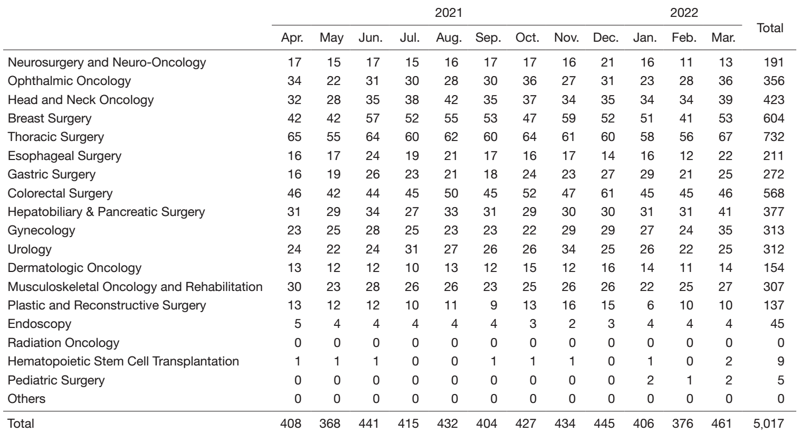Annual Report 2021
Surgical Center
Tetsufumi Sato
Introduction
In the operating rooms, 15 surgical oncology departments perform surgical operations. Highly difficult endoscopic therapies and bone marrow harvesting are also performed in the operating rooms under general anesthesia. We strive to provide the best surgical care to our patients through the cooperation of multiple professions, including anesthesiologists, nurses, clinical engineers, radiological technicians, pharmacists, and medical clerks.
The Team and What We Do
5436 surgeries were performed in the operating rooms between April 2021 and March 2022. Among these, 5017 were surgeries managed by anesthesiologists, while 439 were performed under local anesthesia managed by various departments (Tables 1 and 2). The number of surgeries decreased in FY2020 by about 10% from the previous year due to the COVID-19 pandemic, but showed a recovery trend in FY2021.
Preoperative PCR testing for COVID-19 was performed on all surgical patients to prevent mass infection by COVID-19 in the operating rooms and for safe postoperative management. All staff continued to wear N95 masks and face shields in FY2021, in case of COVID-19 infection in patients.
Brain surgery has been performed in the MRI operating room since 2011, and renovation of the MRI operating room began in March 2021. With the installation of two “da Vinci Xi” surgical robots, robotic surgery is now performed in the Departments of Urology, Colorectal Surgery, Esophageal Surgery, Gastric Surgery, and Gynecology. 286 robot-assisted surgeries were performed in FY2021, and the number of robot-assisted surgeries performed in each clinical department is shown in Table 3.
Clinical engineers who are responsible for the inspection and maintenance of medical equipment are assigned to the operating rooms. In recent years, the number of laparoscopic and thoracoscopic surgeries has been on the rise. Clinical engineers are responsible for preoperative preparation and postoperative maintenance of the “da Vinci” surgical robot, and the number of cases handled increased in FY2021.
Table1. Number of operations (Apr. 2021 - Mar. 2022)

Table 2. Number of anesthesia cases (Apr. 2021 - Mar. 2022)

Table 3. Number of robotic surgeries (Apr. 2021 - Mar. 2022)

Education
In the wake of the COVID-19 pandemic, the operating room training program for foreigners has been temporarily suspended since FY2020. Thus, the training program for foreigners was also suspended in FY2021, while many operating room observations were conducted as part of surgical training and student training, which are required for acquiring robotic surgery certification.
Future prospects
We will work to improve the quality of the operating rooms and aim to achieve 6,000 surgeries by 2023.
